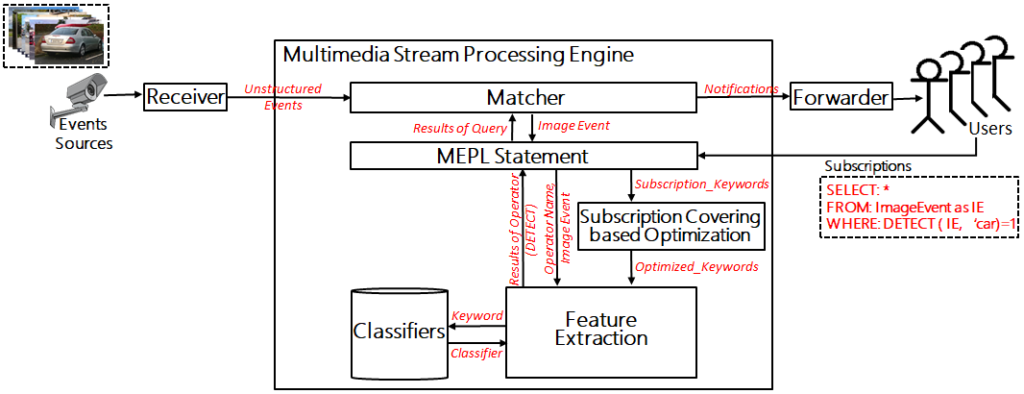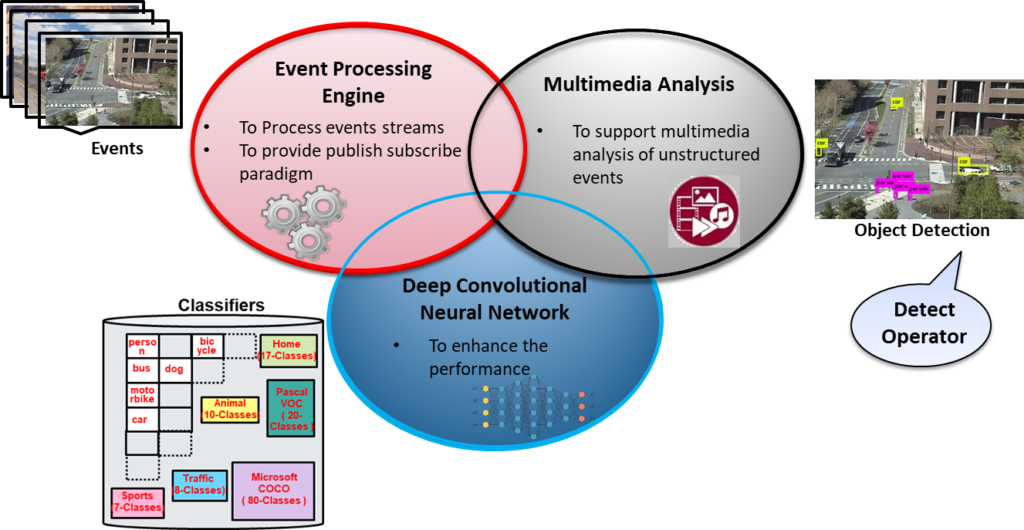In order to accomplish the goal of processing multimedia-based events with high performance (high accuracy with low execution time) while leveraging Publish-Subscribe (Pub/Sub) paradigm, the proposed system must first design and implement an event processing engine with multimedia analysis using deep convolutional neural network (DNN) based techniques [1, 2]. The incorporation of event-based systems with multimedia analysis (shown in Figure 1) provides the support for processing of multimedia events streams within Pub/Sub and allow inclusion of new operators. Presently a detect operator “Boolean DETECT (Image_Event, Keyword)” has been developed to provide the requisite DNN based feature extraction, for the purpose of detection of objects inside image events.
On arrival of a new subscriptions (like bus, car, person), proposed system first finds commonalities among subscriptions for subscription covering based optimization using keywords, then identify classifiers according to the subscribed keyword, apply the object detection, and finally notify the user on the matching of image event with subscription. Since large number of classes in a single classifier may reduce the performance, we also proposed a subscription-based optimization technique “Classifier Division and Selection”, which rely on division of classifiers on the basis of domain and selection of classifiers on the basis of subscriptions. The Pub/Sub based multimedia event processing model is shown in Figure 2, that consists of a matcher, Multimedia Event Processing Language (MEPL) statement, Subscription Covering based Optimization, feature extraction and a collection of classifiers.
Matcher: The matcher is responsible for the detection of conditions which hold in image events according to the user query (which has been evaluated using MEPL statements) and the propagation of notifications to the forwarder according to the condition detected in multimedia events.
Multimedia Event Processing Language (MEPL): Subscriptions are received by MEPL Statement, with “Image Event” from matcher which analyzes the structure of query and instantiates a feature extraction model while using Subscription Covering based Optimization for filtering commonalities. MEPL will be responsible for resolving the signatures of operators associated with multimedia event-based query languages such as the “Detect” operator in the present scenario.

Subscription Covering based Optimization: Subscription Covering based Optimization receives subscribed keywords with identifiers of subscribers from MEPL. It removes common keywords to consider them only once for further processing of multimedia events and sends the aggregated subscriptions to the Feature Extraction model. For instance, if multiple subscribers are looking for the same object (say “person”), then the keyword “person” should be analyzed once associated with multiple subscribers.
Feature extraction: The feature extraction model performs operations on image events according to the subscriptions using image processing operators (“detect” operator in the present case) and a collection of classifiers. The DNN based feature extraction model is presently using “You Only Look Once” for the purpose of object detection. Object detection is used for extraction of image features as it is the most common problem in the context of smart cities. Subscriptions from subscribers in the form of “keywords” will also direct the feature extraction model to use suitable classifiers.
The feature extraction model also facilitates the proposed system to include multiple types of operators for processing different features of the multimedia events which also makes it easily transportable to multiple domains and hence generalizable.
Classifiers: DNN based feature extraction model interacts with classifiers using keywords which is a key requirement of the proposed optimization methodology. Classifiers are trained on classes belonging to real-world objects to perform detection. The number of classes per classifier configuration may vary with a change of domains and will be responsible for the robustness of the system. The input “keywords” will direct a feature extraction model to choose the suitable classifiers for the processing of image events.
Figure 3 demonstrates the flow of subscriptions for the optimization of Pub/Sub based multimedia event processing model.

References
- Asra Aslam and Edward Curry. “Towards a generalized approach for deep neural network based event processing for the internet of multimedia things.” IEEE Access 6 (2018): 25573-25587.
- Asra Aslam, Souleiman Hasan, and Edward Curry. “Challenges with image event processing: Poster.” Proceedings of the 11th ACM International Conference on Distributed and Event-based Systems. 2017.
